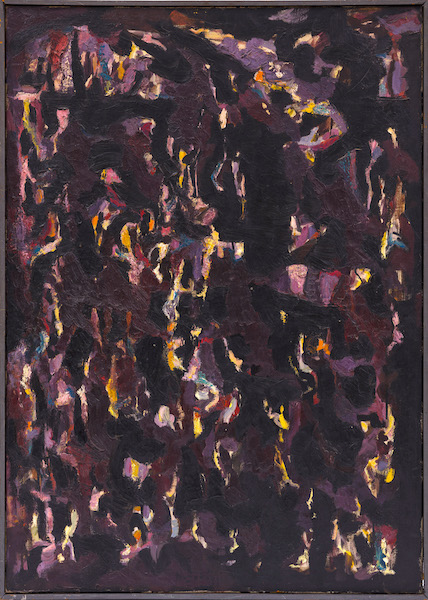Biography
Because of his imprisoned father, the young Hortobágyi - although he stood out from his contemporaries by far with his artistic talent - after graduating from the High School of Fine and Applied Arts, was not accepted to the College of Fine Arts despite his several attempts. So from here on he trained as an autodidact. He met Sándor Molnár, under whose influence he joined the Zugló Circle in 1962. This short period, covering only six years, brought him neither fame nor recognition, but it had an even stronger influence on the development of his painting. In the 1960s, he appeared in several banned and illegal exhibitions individually or together with other painters of the circle. With the breakup of the Zuglói Circle, Hortobágy fell into a vacuum: he is not found in the 1968 and 1969 Industrial Plan exhibitions, nor in the Szüren exhibition organized by Attila Csáji. He only exhibited in 1973 during the Balatonboglár chapel exhibitions organized by György Galántai.
After twelve years of complete isolation, he was discovered in 1985 by Gábor Andrási, who exhibited his works in Óbuda. After that, from the second half of the eighties until his death in 1998, another active period followed, when he managed to present himself in a total of five individual exhibitions, the most important of which was the retrospective exhibition organized in 1996 at the Ernst Museum.
In his paintings, taken at the beginning of the 1960s, we see a peculiarly unique pictorial world, which is built of static, dense forms demarcated by strong outlines. In these pictures, the dialogue between planar forms and the negative image fields resulting from their absence gives rise to the map-like order of forms, which although evokes the feeling of landscape, but its starting point is not the visible nature, but rather the late fifties and early sixties, mainly with walnut wood stain , as well as form studies painted with ink on paper. By using constructive elements from French abstraction, and then making the construction the controlling order of the image, he arrived at a particularly individual, hard-structured lyrical abstraction.
In the 1970s, his painting first moved in the direction of geometry: in his pictures, sharply separated forms are represented by flat, homogenous color surfaces, which are mostly manifested in the dynamics of geometric flat shapes that move out of equilibrium and seek new relationships with each other. Strong, vivid color harmonies reinforce or contrast these situations. Unfortunately, we only know a few such images. In the period following the geometric images - still in the early seventies - his painting moves in the direction of organic forms and almost minimalist colors. He is mostly interested in the connections of closed shapes and the compositional solutions inherent in them. The plastically intertwined forms with brown tones preserve the compositions of the plane-like walnut wood stain sketches from the early 1960s and surpass them with their spatial effect and subtle tonal transitions.
At the beginning of the nineties, Hortobágyi goes back to the walnut wood stain studies he made in the early sixties, but at that time he used them to search for form and experiment with compositional sketches; works almost exclusively with ink or colored ink. Many masterpieces are hidden in the hundreds of data stored in many places for more than two decades. Dozens of the monochrome images, measuring 70 × 50 cm on average, and mainly in portrait format, can stand their ground as independent paintings, but most of them are more like studies, defined by a few vigorous movements, an attempt to find a harmonious form. Each found composition is repeated several times identically or more and more clearly in the group of works. Certain pieces appear in several sizes, others in several color variants. And some of them were made into large-scale oil-on-canvas pictures. Minimizing the number of painterly tools, these are extremely diverse works: the scale ranges from compositions built from closed, block-like or heavy brush marks to the fragrant sensitivity of open, airy, transparent layers of paint. It goes from complex, almost inseparable spatial forms to the minimalism of a few parallel brush marks. These are images of the harmony of the found gesture, in which musicality: rhythm and dynamics also play an important role.

.jpg?locale=en)